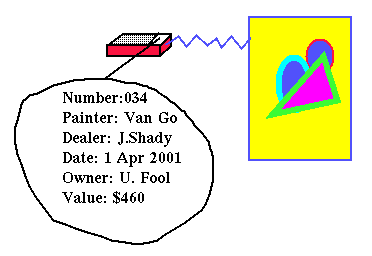
This seemed like a good idea, but of course it's already been done. However, it could become a lot more widespread as a means of keeping track of things, if the cost was reasonable (under $1 per tag, $100 for a scanner).
With me, it started as a joke about keeping track of children's toys in the house. Tag them all, then when one is lost drag out the scanner, dial up the code for "Adolphus Bear", then point the scanner all around the house until you get an answer. Then I thought about the problems I'd had trying to recover some stolen antique furniture. Imagine the Star Trek tricorder - if objects were tagged, you could get that kind of detailed response.
A few years ago I made some electronic modules with an EPROM device containing a user manual, serial number and modification history. The module had to be connected to a computer to read this information, but with an RFID you would just have to point a scanner at it.
Each tag has a permanent, uneraseable serial number and optionally additional programmable areas. Through a registry system, given a serial number (which may be very large, perhaps 512 bits), one can determine a manufacturer or registry service, which will be able to identify further fields within the serial number, and so on. There is no requirement for any one agency to possess the complete codes for any one object. A manufacturer may only identify a particular series as being shipped to a particular distributor.
One existing numbering scheme that might be used is the UPC (EAN or barcode identifier). See e.g. News Scientist LastWord: Cracking Codes.
In the case of low-value items (such as stuffed toys..), objects may be manufactured without unique numbers. The part that is programmed, however, would enable a user to identify the manufacturer, determine washing instructions, fabric content, instructions, etc. A user area can be provided for people to customize - "My name is Adolphus and I belong to Cindy. Please email cindy@anon.org if you find me.", perhaps, for the stuffed toy.
High-value items would possess an uneraseable unique serial number. Although programmable tags would be available to consumers to tag personal items, these would have a distinct unerasable address space and thus could not easily be substituted for an OEM tag, which would in most cases be moulded into the construction of the item.
Identifying the legal owner of a valuable object becomes relatively simple. From the serial number, one can descend the levels of registry to determine the retailer, who would have registered the sale. Registration would be optional for many items but mandatory for others such as weapons. Personal sales could be registered with a registry or with the manufacturer - it is always possible to determine how to do this using a personal scanner. Some information could be dual-key encrypted if required; for instance, if all information was public, one would not want ones address available on hand luggage for anyone to scan and pass to a confederate in the housebreaking business back home.
Variable part (large tag space) (=> is pointer to):
[ => Charset ID][ => datecode]
[ => tag manufacturer][ => tag model no.]
[ => object manufacturer][ => object model no.]
[ => object serial number]
[ => owner encryption scheme]
[ => owner details][ => purchase date]
[ => user area]
[Charset ID][datecode]
[purchase date][object manufacturer]
etc.
A self-documenting database format - you get the idea. The format should be
as open and unambiguous as possible, especially such things as language,
date code, etc.
![[Home]](/maint/home.png)